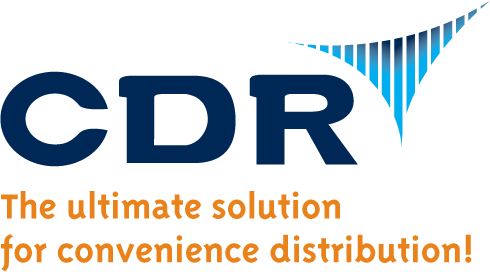Navigating the choice between WMS vs ERP can be challenging for convenience distribution companies. This guide highlights the benefits of each and explains why a solution like CDR Software’s DAC ERP, with its integrated WMS functionality, is an ideal choice.
Imagine you’re at the helm of a thriving convenience store distribution company. Every day, you’re juggling multiple tasks, from ensuring accurate inventory levels to streamlining warehouse operations and managing various business processes. The efficiency and success of your company hinge on the systems you use to manage these tasks. This is where understanding the differences and benefits of Warehouse Management Systems (WMS) and Enterprise Resource Planning (ERP) systems becomes crucial. In this guide, we’ll dive deep into these systems, their unique advantages, and why an ERP with built-in WMS functionality might be the best solution for your business.
Understanding WMS vs ERP: Definition and Functionality
Warehouse Management Systems (WMS)
A Warehouse Management System (WMS) is a software application designed to optimize warehouse operations. Its primary functions include inventory control, managing warehouse activities like picking, packing, and shipping, and ensuring goods move efficiently through the warehouse. The key benefits of a WMS include:
- Increased Accuracy: With real-time tracking and automation, a WMS reduces human error in inventory management.
- Improved Efficiency: Streamlining warehouse operations leads to faster order fulfillment.
- Reduced Labor Costs: Automation and optimized workflows decrease the need for manual labor.
Enterprise Resource Planning (ERP)
An Enterprise Resource Planning (ERP) system is a comprehensive software solution that integrates various business processes across an organization. ERP systems manage and automate functions related to finance, human resources, sales, procurement, and more. The key benefits of an ERP system include:
- Data Centralization: Combines data from different departments into a single system, providing a unified view of the business.
- Improved Reporting: Enhanced data analytics and reporting capabilities for better decision-making.
- Better Resource Management: Efficient allocation and use of resources across the company.
Historical Context
The evolution of WMS and ERP systems has been driven by the increasing complexity of supply chains and the need for integrated solutions to manage them effectively. Initially, businesses relied on separate, siloed systems to handle different functions. This often led to inefficiencies and communication gaps. Over time, the integration of WMS and ERP systems has become essential for modern distribution companies to remain competitive and responsive to market demands.

Key Differences Between WMS vs ERP
Scope and Focus
WMS: A WMS is laser-focused on warehouse operations. It provides specialized tools for managing inventory, optimizing warehouse layout, and ensuring accurate order fulfillment. Its scope is limited to the warehouse environment, making it a powerful tool for improving warehouse efficiency but less effective for broader business processes.
ERP: An ERP system, on the other hand, covers a wider range of business functions. It integrates operations across the entire organization, from finance to human resources to supply chain management. This broad scope allows for comprehensive data analysis and strategic planning. However, in the case of some ERPs on the market, they can lack the specialized tool set of a dedicated WMS.
Implementation and Integration
Ease of Implementation: Implementing a WMS can be more straightforward if the focus is solely on warehouse operations. However, integrating a WMS with existing business systems can pose challenges. An ERP system, while more complex to implement due to its wide-ranging capabilities, often includes built-in modules for various functions, reducing the need for multiple integrations.
Integration with Other Systems: A standalone WMS requires integration with other business systems to provide a holistic view of operations. This can lead to compatibility issues and increased IT complexity. In contrast, an ERP system offers seamless integration across different business functions, providing a unified platform that simplifies data sharing and reduces the risk of errors.
Cost Considerations
Initial and Ongoing Costs: The initial investment for a standalone WMS might be lower compared to an ERP system due to its narrower focus. However, the costs of integrating a WMS with other systems and ongoing maintenance can add up. An ERP system can sometimes have a higher initial cost, but its comprehensive nature can lead to long-term savings by eliminating the need for multiple software solutions.
ROI and Long-Term Financial Benefits: While both systems offer substantial ROI, the long-term financial benefits of an ERP system often outweigh those of a standalone WMS. An integrated ERP system streamlines operations, reduces redundancies, and provides more accurate data for strategic decision-making, leading to improved overall efficiency and cost savings.
The Benefits of a WMS for Distribution Companies
Enhanced Inventory Management
One of the primary benefits of a Warehouse Management System is its ability to provide real-time tracking and accuracy in inventory management. A WMS provides:
- Real-Time Visibility: Monitor inventory levels in real-time, reducing the risk of stockouts and overstock situations.
- Accurate Inventory Tracking: Utilize barcoding, RFID, and other technologies to ensure inventory is accurately tracked from receipt to shipment.
- Automated Replenishment: Set up automated alerts and reorder points to ensure you never run out of critical stock.
Operational Efficiency
A WMS streamlines warehouse processes, resulting in improved operational efficiency. Key benefits include:
- Optimized Warehouse Layout: Implement efficient storage strategies and optimize warehouse layout to reduce travel time and increase picking speed.
- Improved Order Fulfillment: Enhance picking, packing, and shipping processes, leading to faster order fulfillment and increased customer satisfaction.
- Labor Management: Allocate labor more effectively with task management and labor tracking features, reducing unnecessary labor costs and improving productivity.
Data-Driven Decisions
Detailed reporting and analytics provided by a WMS empower distribution companies to make informed, data-driven decisions. Benefits include:
- Detailed Reporting: Access comprehensive reports on inventory levels, order status, and warehouse performance to identify areas for improvement.
- Better Demand Forecasting: Use historical data and predictive analytics to forecast demand accurately and plan inventory accordingly.
- Enhanced Planning: Make strategic decisions based on real-time data, improving overall business performance and agility.
Read more: ERP for Convenience Distribution: Why it’s a Must-Have for Distributors

The Benefits of an ERP System for Distribution Companies
An ERP system that includes a robust WMS module will include all the benefits above plus the following:
Integrated Business Processes
An Enterprise Resource Planning (ERP) system integrates various business processes across the organization, providing a seamless workflow. Key benefits include:
- Unified Platform: Manage all business functions, including finance, HR, procurement, and supply chain, from a single platform.
- Improved Communication: Facilitate better communication and collaboration between departments, reducing silos and enhancing overall efficiency.
- Streamlined Operations: Automate routine tasks and workflows, freeing up time for employees to focus on strategic initiatives.
Centralized Data Management
With an ERP system, data is centralized and accessible across the organization, providing a single source of truth. Benefits include:
- Enhanced Data Accuracy: Reduce data duplication and errors by maintaining a single, centralized database.
- Improved Reporting and Compliance: Generate accurate, real-time reports to ensure compliance with industry regulations and standards.
- Data Security: Protect sensitive business data with advanced security features and user access controls.
Scalability and Flexibility
Leading ERP systems are designed to be scalable and flexible, accommodating the growth and evolving needs of your business. Benefits include:
- Scalability: Easily scale the system as your business grows, adding new users, modules, and functionalities as needed.
- Customizable Modules: Tailor the system to fit your specific business requirements with customizable modules and features.
- Future-Proofing: Stay ahead of the competition with regular updates and enhancements that keep your ERP system current with industry trends and technologies.

The Best of Both Worlds: ERP with Built-In WMS Functionality
Introducing CDR Software’s DAC ERP, a comprehensive solution tailored to the unique demands of c-store distribution. DAC integrates powerful ERP capabilities with advanced WMS functionality. Here’s why DAC ERP stands out as the best choice for convenience distribution companies:
Unified System for Total Control
Combining ERP and WMS functionalities into DAC ERP provides unparalleled control over your business operations. Key benefits include:
- Seamless Integration: DAC ERP ensures that warehouse management is seamlessly integrated with other business functions, such as finance, HR, and sales. This eliminates data silos and promotes a cohesive workflow.
- Consistent Data Flow: DAC ERP ensures consistent data flow between departments, reducing errors and enhancing communication. For example, inventory updates from the warehouse are immediately reflected in the financial and sales modules.
- Holistic View of Operations: With DAC ERP, gain a comprehensive view of your business operations, from procurement to sales, enabling more strategic decision-making and better resource allocation.
Cost and Efficiency Savings
Adopting DAC ERP can lead to significant cost and efficiency savings. Benefits include:
- Reduced IT Costs: Manage and maintain a single system instead of multiple standalone systems, reducing IT complexity and costs.
- Streamlined Implementation: Implementing DAC ERP can be more straightforward and faster than integrating separate systems, minimizing downtime and disruption.
- Operational Efficiency: Streamline processes and reduce redundancies across your organization, leading to improved productivity and lower operational costs.
Improved Visibility and Decision-Making
DAC ERP provides enhanced visibility and data insights, supporting better decision-making. Benefits include:
- Real-Time Data Access: Access real-time data across all business functions, enabling proactive decision-making and quicker response to market changes.
- Advanced Analytics: Utilize advanced analytics and reporting tools to gain deeper insights into business performance, identify trends, and make informed decisions.
- Enhanced Forecasting: Improve demand forecasting and inventory planning with accurate, up-to-date information from both warehouse and other business operations.
Tailored for Convenience Distribution
DAC ERP is specifically designed to meet the unique needs of convenience distribution companies. Benefits for c-store distributors include:
- Specialized Features: Industry-specific features tailored to streamline operations in convenience distribution. This includes dedicated rebate and reporting functionality for important product categories like tobacco and candy.
- Scalability and Flexibility: Easily scale the system as your business grows, adding new users, modules, and functionalities as needed.
- Customer Support: Dedicated support and training to ensure smooth implementation and ongoing success.
By choosing DAC ERP by CDR Software, convenience distribution companies can leverage a powerful, integrated solution that combines the best of both worlds – robust ERP capabilities with specialized WMS functionality built right in. This unified approach not only enhances operational efficiency but also provides a solid foundation for strategic growth and long-term success.
WMS vs ERP Conclusion
In today’s fast-paced and competitive market, convenience distribution companies need efficient, integrated systems to manage their operations effectively. Warehouse Management Systems and Enterprise Resource Planning systems each offer significant benefits, from enhancing inventory management and operational efficiency to providing centralized data management and comprehensive business integration.
However, the true power lies in combining these functionalities into a single, unified solution. CDR Software’s DAC ERP provides the best of both worlds, offering robust ERP capabilities and advanced WMS functionality. This integrated approach eliminates data silos, streamlines operations, and supports data-driven decision-making, all while being tailored to the unique needs of convenience distribution companies.
By choosing DAC ERP, you’re not just investing in software; you’re investing in the future success and growth of your business. Enjoy seamless integration, improved efficiency, and a holistic view of your operations that empowers you to make strategic decisions with confidence.
Ready to take your convenience distribution business to the next level? Discover how DAC ERP can transform your operations with its integrated ERP and WMS functionality. Contact us today to learn more, schedule a demo, or speak with one of our experts.
WMS vs ERP FAQs
What’s the main difference between WMS and ERP systems?
A Warehouse Management System (WMS) focuses on streamlining your warehouse operations, like managing inventory and ensuring smooth picking, packing, and shipping. An Enterprise Resource Planning (ERP) system, on the other hand, integrates various business processes such as finance, HR, sales, and procurement into one cohesive system, giving you a comprehensive view of your entire business.
Can I use a WMS without an ERP system?
Yes. A WMS can work independently and is great for handling warehouse-specific tasks. However, integrating it with an ERP system offers more benefits, like improved data flow between departments and a better overall view of your business operations.
What are the cost implications of implementing an ERP system with built-in WMS functionality?
While an ERP system with built-in WMS functionality can have a higher upfront cost compared to a standalone WMS, the long-term benefits can be substantial. You’ll save on IT costs, streamline your operations, improve data accuracy, and make better business decisions, leading to overall cost savings and increased efficiency.
How does DAC ERP boost efficiency for convenience distribution companies?
DAC ERP enhances efficiency by seamlessly integrating warehouse management with other business functions. This reduces redundancies, ensures consistent data flow, speeds up order fulfillment, optimizes resource allocation, and provides real-time visibility into your business performance, helping you make more strategic decisions.
What should I consider when choosing between a standalone WMS and an ERP with integrated WMS functionality?
Here are a few things to consider:
- Business Needs: If you’re looking to optimize just your warehouse operations, a standalone WMS might be enough. For comprehensive business management, an ERP with built-in WMS is a better choice.
- Integration: An integrated ERP system ensures smooth data flow across departments, reducing errors and improving communication.
- Cost and ROI: Think about the long-term savings and return on investment from using an integrated system versus multiple standalone systems.
- Scalability: Consider how well the system can grow and adapt as your business expands.
How does DAC ERP help with data-driven decision-making?
DAC ERP gives you real-time access to data across all business functions, offering advanced analytics and reporting tools for deeper insights into your business. This helps you identify trends, optimize inventory levels, accurately forecast demand, and make proactive, informed decisions.

